Yomi – Kingdom Of The Dead In Japan’s Native Shinto Religion
A. Sutherland - AncientPages.com - The Japanese mythological Kingdom of the Dead is often referred to as Yomi. In Japan's native Shinto religion, Yomi-no-Kuni is the Shinto underworld, as described in the Kojiki, Japan's oldest chronicle and source for many Shinto beliefs across the centuries.
The Yomi's other names include the "Land of The Dead ("Land of Darkness").
Yomotsu Hirasaka is the slope that leads to Yomi. This is Legend place in Higashiizumo, Shimane, Japan. ChiefHira - CC BY-SA 3.0
It was considered a place of darkness full of demons and evil gods who attacked and pursued all who got there.
The ruler of this terrible Kingdom was Emma-O, the judge of the dead, who lived in an underground castle made of metals and gemstones mined from the underworld.
When evil people died and came to Yomi, they were forced to wear signs around their necks with a list of their sins. Based on the sins, Emma-O pronounced his verdict over the deceased who were put before him. He punished the guilty souls and sent the innocent to earth to be reborn.
In Yomi, there were 80,000 demons whose task was to carry the dead to the realm of the dead, introduce them to Emma-O, and then torture them according to his orders and his verdict.
The underworld is the prominent place destined for all who die and must enter this realm for a trial. In Brittany's fairy folklore, a frightening spirit Ankou ("death"), appears as a dark shadow driving a black cart pulled by four black horses and assisted by two skeletons who help Ankou to collect the souls of the dead.
The Aztec and Mayan mythologies describe what will happen to the spirit once the individual has died.
Kobayashi Izanami and Izanagi. Painting by Eitaku Kobayashi showing Izanami and Izanagi consolidating the land with the spear "Ama-no-Nuboko" - Public Domain
The ancient Maya believed that the underworld – Xibalba, was a terrible, nine-leveled underground place of fear ruled by the lords of death. In some old accounts, it is a domain of evil demons, busy plotting against heaven's gods. In other versions, Xibalba is a place of decay and disease and a destination for human souls after death. The Aztecs believed that each soul wandered through the layers of Mictlan until it reached the deepest level.
The fate of the deceased was determined based on how this person died.
In one story, Izanami ('Female-who-invites'), one of seven gods in Japanese mythology, died and entered the Yomi ("Land of Gloom"). Izanagi, her husband, descended to Yomi to get his wife back. She agreed to return with him to the world of the living, but only on the condition that he would wait for her without entering the Land of the Dead. Unfortunately, Izanagi did not keep his promise. He approached Izanami's dead body and saw it decomposing and full of worms while eight gods of thunder guarded the whole ritual.
The Land of the Living and the Land of the Dead have laws and prohibitions.
According to ancient Japanese beliefs, outsiders should not disturb and observe the rejuvenation process. The dead should not be observed during the process of transition. Izanagi broke Yomi's rules.
Finally, horrified Izanagi managed to flee to the world of the living, but it cost him. The demons and gods of thunder chased him, and he had to use his magic, sword, and other magic items to escape.
*Running for life, he approached the underworld's gates and stumbled upon a peach tree. This tree was certainly not any ordinary tree but must have had certain magical powers. Plucking three peaches from this tree, "he hurled them at his attackers and drove them back into the underworld.
This time, Izanami herself went after him. Izanagi took a giant boulder and blocked the entrance to Yomi-no-Kuni, forever separating the underworld from the earth and himself from Izanami. Here they said their final farewells." 1
This terrible experience made him feel nasty and dirty, but it was worth the effort. The boulder remains to block the passage to the underworld. "The passage to the underworld may not be a physical space, but rather, a state or period between when you stop breathing and actually die. 1
Written by – A. Sutherland - AncientPages.com Senior Staff Writer
Updated on December 16, 2023
Copyright © AncientPages.com All rights reserved. This material may not be published, broadcast, rewritten or redistributed in whole or part without the express written permission of AncientPages.com
More From Ancient Pages
-
 Was Organized Society A Disruptive Or Calming Force In Ancient Andes Populations?
Archaeology | Oct 24, 2024
Was Organized Society A Disruptive Or Calming Force In Ancient Andes Populations?
Archaeology | Oct 24, 2024 -
 Neanderthals Were Present In Italy Much Earlier Than Previously Thought
Archaeology | Nov 6, 2015
Neanderthals Were Present In Italy Much Earlier Than Previously Thought
Archaeology | Nov 6, 2015 -
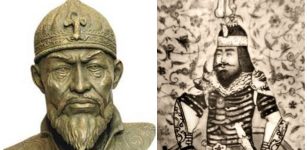 On This Day In History: Turco-Mongol Emperor Timur Sacks Damascus – On Mar 24, 1401
News | Mar 24, 2017
On This Day In History: Turco-Mongol Emperor Timur Sacks Damascus – On Mar 24, 1401
News | Mar 24, 2017 -
 How Did A Piece Of An ‘Epic’ Viking Sword End Up In The Netherlands?
Vikings | Dec 4, 2024
How Did A Piece Of An ‘Epic’ Viking Sword End Up In The Netherlands?
Vikings | Dec 4, 2024 -
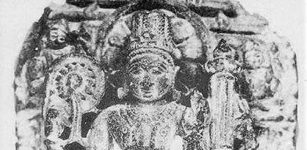 Dwarka – Pre-Harappan City That Could Rewrite The History Of The World
Civilizations | Aug 19, 2014
Dwarka – Pre-Harappan City That Could Rewrite The History Of The World
Civilizations | Aug 19, 2014 -
 Easter Island’s Society Was Sophisticated And Its People Shared Information And Collaborated
Archaeology | Aug 14, 2018
Easter Island’s Society Was Sophisticated And Its People Shared Information And Collaborated
Archaeology | Aug 14, 2018 -
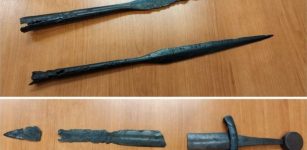 Swords And Spears Of The Yotvingians – A Long-Forgotten Ancient Warrior Culture Discovered In Poland
Archaeology | Jan 6, 2020
Swords And Spears Of The Yotvingians – A Long-Forgotten Ancient Warrior Culture Discovered In Poland
Archaeology | Jan 6, 2020 -
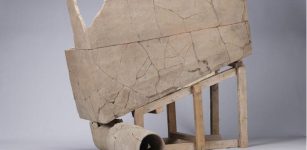 2,400-Year-Old Flush Toilet Discovered In China
Archaeology | Feb 24, 2023
2,400-Year-Old Flush Toilet Discovered In China
Archaeology | Feb 24, 2023 -
 Secrets Of The Uruk Prophecy Found In The Ancient Library Of A Magician With Divine Powers
Featured Stories | Mar 18, 2025
Secrets Of The Uruk Prophecy Found In The Ancient Library Of A Magician With Divine Powers
Featured Stories | Mar 18, 2025 -
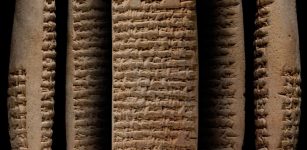 Mystery Of The Proto-Elamite Tablets – Cracking The World’s Oldest Undeciphered Writing
Artifacts | Oct 29, 2012
Mystery Of The Proto-Elamite Tablets – Cracking The World’s Oldest Undeciphered Writing
Artifacts | Oct 29, 2012 -
 Incredible Ancient Machines Invented By Hero Of Alexandria – An Engineer Far Ahead Of His Time
Featured Stories | Jun 3, 2020
Incredible Ancient Machines Invented By Hero Of Alexandria – An Engineer Far Ahead Of His Time
Featured Stories | Jun 3, 2020 -
 Mysterious White Mass On The Heads Of The Tarim Basin Mummies Identified
Archaeology | Oct 1, 2024
Mysterious White Mass On The Heads Of The Tarim Basin Mummies Identified
Archaeology | Oct 1, 2024 -
 On This Day In History: Ruler Of Palenque Yohl Ik’nal Was Crowned – On Dec 23, 583
News | Dec 23, 2016
On This Day In History: Ruler Of Palenque Yohl Ik’nal Was Crowned – On Dec 23, 583
News | Dec 23, 2016 -
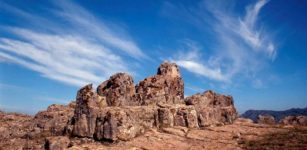 4,000-Year-Old Lunar Calendar Developed At Kokino Megalithic Observatory – Evidence Of Remarkable Astronomical Knowledge
Archaeoastronomy | Jan 9, 2021
4,000-Year-Old Lunar Calendar Developed At Kokino Megalithic Observatory – Evidence Of Remarkable Astronomical Knowledge
Archaeoastronomy | Jan 9, 2021 -
 Easter Island Secrets: Giant ‘Pukao’ Stone Hats Reveal That Rapa Nui People Were Not Warriors
Archaeology | Dec 22, 2017
Easter Island Secrets: Giant ‘Pukao’ Stone Hats Reveal That Rapa Nui People Were Not Warriors
Archaeology | Dec 22, 2017 -
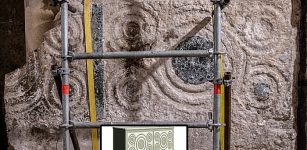 Graffiti Reveals Crusaders’ Beautiful Altar In The Church Of The Holy Sepulchre
Archaeology | Jul 24, 2024
Graffiti Reveals Crusaders’ Beautiful Altar In The Church Of The Holy Sepulchre
Archaeology | Jul 24, 2024 -
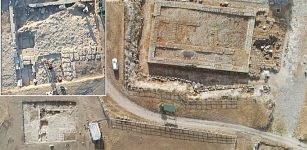 Previously Unknown Monumental Etruscan Temple Found Near The Tempio Grande, Vulci, Latium, Italy
Archaeology | Nov 10, 2022
Previously Unknown Monumental Etruscan Temple Found Near The Tempio Grande, Vulci, Latium, Italy
Archaeology | Nov 10, 2022 -
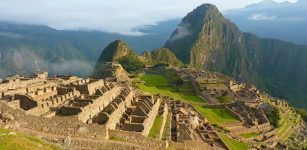 Machu Picchu: Ancient Incan Sanctuary Intentionally Built On Faults
Archaeology | Sep 27, 2019
Machu Picchu: Ancient Incan Sanctuary Intentionally Built On Faults
Archaeology | Sep 27, 2019 -
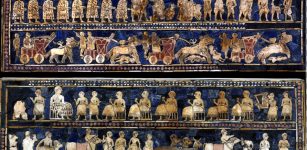 Image Of The Day: ‘The Standard of Ur – War And Peace’
Civilizations | Sep 7, 2015
Image Of The Day: ‘The Standard of Ur – War And Peace’
Civilizations | Sep 7, 2015 -
 4,000-Year-Old Tomb Altóir Na Gréine Rediscovered By Folklorist In County Kerry, Ireland
Archaeology | Jan 24, 2024
4,000-Year-Old Tomb Altóir Na Gréine Rediscovered By Folklorist In County Kerry, Ireland
Archaeology | Jan 24, 2024


